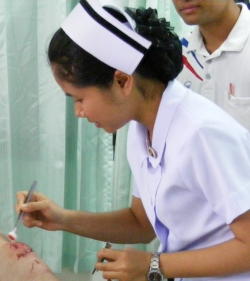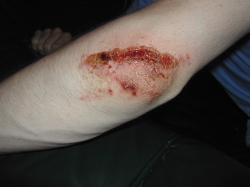Have you ever watched a motorcycle speed along the road? Maybe you have even been on one yourself. Machines like these need lots of different parts to make them work. Of course a motorcycle needs wheels. The engine is also very important. Inside are parts that turn, spin, spray, and spark. These parts help create the energy that gives the motorcycle power. They need gasoline to make energy. Even with all of the right parts, a motorcycle is not going anywhere without fuel!

Only twenty miles to the next gas station.
Just like a motorcycle, your body is made up of different parts that all work together so that you can enjoy life. Believe it or not, your body is even more complicated than a motorcycle! In some ways, your blood is like the motorcycle's fuel. Without your blood, you would not be able to live. Your blood carries important things all around your body. It gets the power to do this from your heart. Within your body, your blood itself is made up of many different parts that work together too. Each of these parts of your blood has its own job to do.
Blood has the job of bringing oxygen to all of your organs and cells. Red blood cells are the cells in the blood that carry oxygen. They are the only cells in your entire body that can do this. However, red blood cells cannot carry oxygen by themselves; iron helps your red blood cells do their job. When you think of iron, you might think of strong, metal buildings, but there is also iron inside of your blood. Of course you cannot eat metal buildings to get your iron; instead, you get iron into your blood from eating many common foods that contain iron.
Your blood has more red blood cells than any other kind of blood cell. This makes sense, because your body always needs oxygen at all times. However, doing things like running or dancing makes you need even more, since moving your muscles uses oxygen. Think about how hard your red blood cells are working the next time that you run or dance and find yourself out of breath.

That was easy. Let's do it again tomorrow.
John Marino, CC0, via Wikimedia Commons
Your blood also works to keep your healthy, and this job is the responsibility of the white blood cells. White blood cells are blood cells that fight off sickness. Since you are not always sick, you do not have as many white blood cells in your blood as you have red blood cells. However, when you do get sick, your body makes more white blood cells to help fight off the sickness. White blood cells are also much bigger than red blood cells.
There are several different kinds of white blood cells, and each different kind has its own special job. All of these types of white blood cells work in some way or another to fight off sickness. For example, when you get a cut, one kind of white blood cell rushes to the place of the cut and helps to get rid of any germs that might cause an infection. At the same time, other white blood cells hunt down and destroy anything that does not belong in your blood, like the things that make you sick. Just like doctors or nurses who wear white coats, white blood cells work to fight off sicknesses.

This might sting just a little bit.
Bualong Sebulke, Public domain, via Wikimedia Commons
While your white blood cells fight off any bad things that might try to get into your body through cuts, another kind of cell in your blood also rushes to the place of a cut. This type of cell is called a platelet, and it is a cell in your blood that causes your blood to stop flowing when you get hurt. These cells are very small and round and are purple in color. In order to stop too much of your blood from leaving your body through a cut, platelets form something called a clot. A clot is a bunch of blood cells stuck together that keeps any other blood from flowing through that blood vessel.

Ouch, that's going to leave a mark!
ARC Gritt, Public domain, via Wikimedia Commons
In a way, these cells are like werewolves. When one of these cells finds a cut (a broken blood vessel), it sends out a message to all of the other platelets in your blood. The message tells other platelets to rush to the cut; at the same time, these cells will also be sending out their own messages, calling for more and more platelets. This is a lot like how a werewolf would howl for other werewolves to join him. Once the flow of blood has been stopped, no more "howling" is needed.
Finally, your blood also has one other major part. Plasma is the liquid part of your blood that carries everything that is in blood. This means that it carries all of the blood cells, as well as the good things that your body gets from the food you eat and the messages that are sent in your blood. Plasma also carries the things that cells do not need away from them; these things are called "waste." Even though your blood is red, if you were to separate out the plasma you would see that it is yellow. Plasma is mostly made up of water, but it has all of the other things that are in blood in it too. If your blood were vegetable soup, then your plasma would be the soup part and your blood cells would be the vegetables.
Every part of your blood is important. If you did not have red blood cells, then your blood could not carry oxygen to all of your muscles. If you did not have white blood cells (the "doctor" cells), then you would be sick all of the time. If you did not have platelets (the "werewolf" cells), then your blood would not stop flowing out of your body every time you got a cut. If you did not have plasma, then your blood would not able to flow through your body because it would not have enough water in it to move. Without any one part of your blood, you would not be able to live!